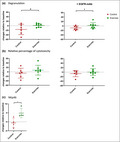- Record: found
- Abstract: found
- Article: found
Effects of physical exercise on natural killer cell activity during (neo)adjuvant chemotherapy: A randomized pilot study

Read this article at
Abstract
Natural killer (NK) cells are a population of innate immune cells known to play a pivotal role against tumor spread. In multiple murine models, it was shown that physical exercise had the potential to increase NK cell antitumor activity through their mobilization and tissue redistribution in an interleukin (IL)‐6 and epinephrine‐dependent manner. The translation of this finding to patients is unclear. In this randomized pilot trial, we analyzed blood samples of patients with resectable breast or colon cancer who were randomized into an evidence‐based moderate‐high intensity resistance and aerobic exercise intervention ( n = 8) or a control group ( n = 6) during the first 9–12 weeks of (neo)adjuvant chemotherapy. In this pilot, we did not solely focus on statistical significance, but also explored whether average between‐group differences reached 10%. NK cell degranulation was preserved in the exercise group whereas it decreased in the control group resulting in a between‐group difference of 11.4% CD107a + degranulated NK cells (95%CI = 0.57;22.3, p = 0.04) in the presence and 13.8% (95%CI = −2.5;30.0, p = 0.09) in the absence of an anti‐epidermal growth factor receptor monoclonal antibody (EGFR‐mAb). In line, the between‐group difference of tumor cell lysis was 7.4% (95%CI = −9.1;23.9, p = 0.34), and 13.7% (95%CI = −10.1;37.5, p = 0.23) in favor of the exercise group in the presence or absence of EGFR mAb, respectively. Current explorative analyses showed that exercise during (neo)adjuvant chemotherapy may benefit NK cell activity. Future studies with a larger sample size are needed to confirm this finding and to establish its clinical potential.
Trial registration: Dutch trial register number NTR4105.
Abstract
We analyzed blood samples of patients with resectable breast or colon cancer who were randomized into an evidence‐based exercise intervention ( n = 8) or control group ( n = 6) during the first 9–12 weeks of (neo)adjuvant chemotherapy. NK cell degranulation was preserved during exercise and, although not statistically significant, cytotoxicity levels were 7%–14% higher compared to controls suggesting that physical exercise during (neo)adjuvant chemotherapy might benefit NK cell activity.
Related collections
Most cited references20
- Record: found
- Abstract: found
- Article: not found
Functions of natural killer cells.
- Record: found
- Abstract: found
- Article: not found
